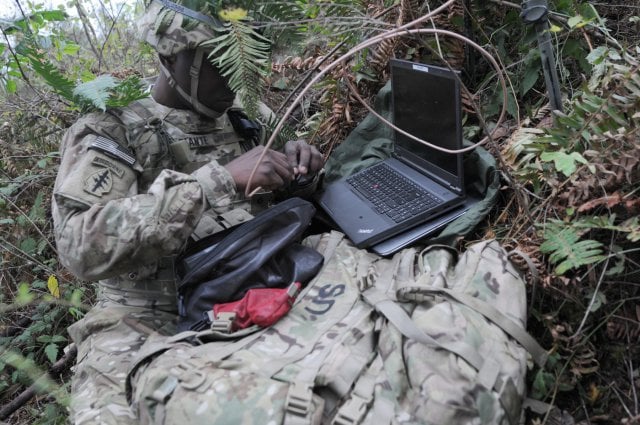
A soldier from the Army’s offensive cyber brigade during an exercise at Fort Lewis, Washington.
ARLINGTON: To see through the fog of war on future battlefields, ground troops will need near-real-time access to huge amounts of information from a host of sensors — from satellites to F-35s to mini-drones to targeting goggles, all sharing data through a joint combat cloud. But to evade the enemy’s own swarms of sensors, soldiers will also need to know when to disconnect from the network and go dark.
Switching quickly from being hyperconnected to being cut off — whether as a tactical choice or as the result of enemy jamming and hacking — will put a new kind of strain on future frontline commanders. The capability to cope is central both to the Army’s evolving combat concept, Multi-Domain Operations, the Pentagon’s controversial Joint Enterprise Defense Initiative, the JEDI cloud computing program.
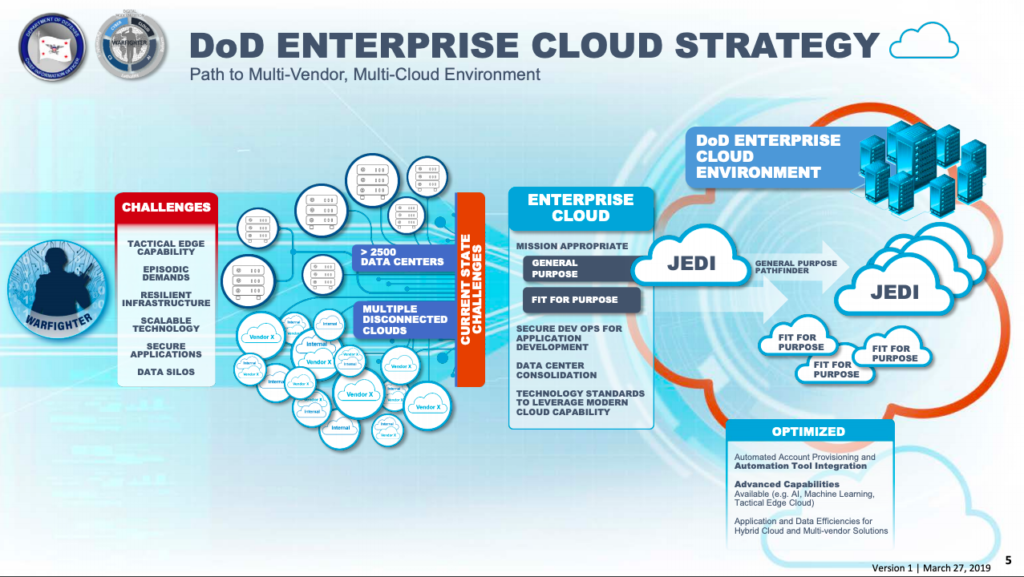
The Pentagon’s plan to consolidate many — but not all — of its 500-plus cloud contracts into a single Joint Enterprise Defense Infrastructure (JEDI). Note the suggestion that the single “pathfinder” contract for JEDI might evolve into multiple JEDI contracts.
The Case For Cloud
“Why do we want to go to the cloud? Because you get better synthesized data,” said the Army’s senior futurist, Lt. Gen. Eric Wesley, in a recent conversation with reporters. “Sensors are going to be ubiquitous on the battlefield,” he said. They’ll provide such masses of data that unaided human brains and traditional staff processes can’t collect it all in one place, let alone make sense of it: “It’s got to be synchronized by tools such as artificial intelligence and cloud-based computing.”
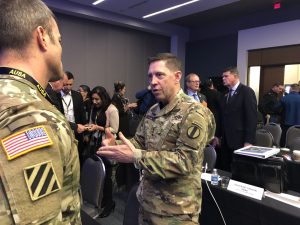
Lt. Gen. Eric Wesley talks to a fellow soldier at an AUSA conference on artificial intelligence.
“If I am a warfighter, I want as much data as you could possibly give me,” said the head of the Joint Artificial Intelligence Center, Air Force Lt. Gen. Jack Shanahan, at a separate roundtable. “Let me use my algorithms to sort through it … at machine speeds…It’s really hard for me to do that without an enterprise cloud.”
“But you won’t necessarily have access to that all the time,” Wesley warned. “You can imagine where a given [unit] will be off the net for a period — maybe go dark, not unlike the way submarines operate now. ”
While disconnected, troops will have to make do with whatever data they’ve already downloaded, perhaps to a backpack mini-server with built-in AI. Then, Wesley continued, “when you’re back up on the net, you might need to do a download, adjust your algorithms, adjust your data.”
“You’re going to have balance both cloud computing and computing at the edge,” Wesley said. “It’s absolutely a form of maneuver.” Transmitting and going silent, uploading and downloading, will need to be as well-practiced and intuitive as digging in a hasty defense or laying an ambush.
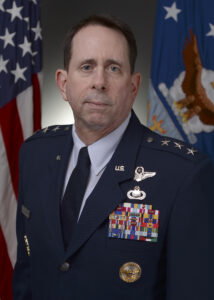
Lt. Gen. John “Jack” Shanahan
Wesley, who works for Army Futures Command, didn’t mention the all-service JEDI program by name. But Shanahan, who reports to the Pentagon CIO, made the link explicit.
“JEDI will include cloud capabilities that are able to operate out of standalone, portable hardware even in the absence of communications links,” Shanahan said. “It will re-synch with the rest of the JEDI cloud as soon as communications are restored.”
“You have the central JEDI cloud, then you have, maybe, portable data centers that are downrange,” Shanahan explained. “The beauty of that is not only are you getting access to all the benefits of the cloud down to the very edge of the battlefield: As you’re collecting data, that data can then go back into [the central cloud], so everybody is benefiting from that.”
“If you get disconnected, as is going to happen in combat, especially in a high-end fight, you still have what you had at the point it was disconnected,” Shanahan said. Your latest downloads will be saved at the closest local server, which might be in a CONEX shipping container carried by truck to a forward command post or in a pair of soldiers’ backpacks, accessible even when long-range communications fail. Then, he continued, “when it suddenly comes back, you have all of this … connected across the entire enterprise.”
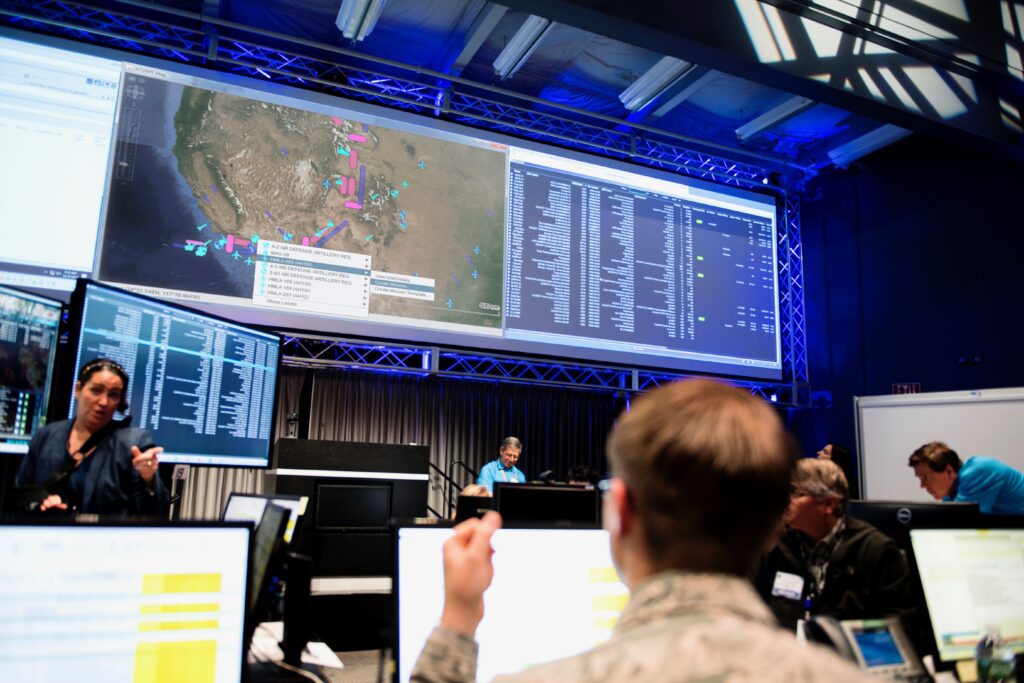
Lockheed Martin’s third Multi-Domain Command & Control (MDC2) wargame
Multi-Domain Command & Control
While JEDI plays a central role in this vision of future warfare, it’s just one part of a much larger push, an Air Force system for communicating and combining all this information, the Multi Domain Command and Control System (MDC2). The goal is to move data from any part of the force, anywhere in the world, in any of the five recognized domains — land, sea, air, space and cyberspace — to any other part, quickly and in useful form. In essence, the Air Force and JEDI are attacking the multi-domain problem from the top down, starting with central servers, higher headquarters, and satellites, while the Army is coming from the ground up, grunt-first.
“Imagine a scout on the reverse side of a tactical slope,” Wesley said. “Imagine an F-35 may have just flown over that slope, that space, in the previous 60 minutes. Those aircraft are going to be taking in all sorts of data. How is the scout going to get access to that data without waiting for a direct point-to-point communication with that aircraft?” The solution, he said, is for all sensors to share their data in a common “combat cloud,” a term which he noted comes from in the Air Force.
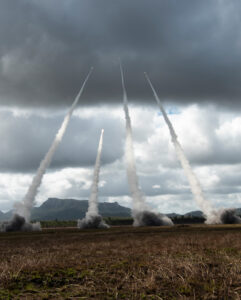
American HIMARS multiple rocket launchers during a live-fire exercise in Australia, part of the Talisman Saber 2019 wargames.
It’s not just intelligence, Wesley went on: It’s targeting data. The ultimate goal is some AI algorithm — carefully monitored and directed by human commanders — that can match a target with the weapon best suited to destroy it, whether that weapon is a strike fighter, a land-based missile launcher, or a warship. A future commander could call for fire support the way today’s urbanites call an Uber
To experiment with how this might work in real life, the Army has already created a brigade-sized Multi-Domain Task Force, whose collective eyes are a battalion-sized Intelligence, Information, Cyber, Electronic Warfare, & Space (I2CEWS) detachment. The original MDTF has been holding wargames and field exercises in the Pacific with the other services and with allies like Australia; a second task force is planned for Europe, and a third will join the first in Asia. After that, Wesley said, the Army plans to develop new organizations like a Theater Fires Command to coordinate long-range strikes by its new thousand-mile missiles.
But this cannot be only an Army effort, Wesley emphasized, and it isn’t. “The Air Force and Army are well aligned in that this future design is going to have to be increasingly joint,” he said. “Headquarters are going to be increasingly purple in the future.”
“We must have a joint concept going forward,” Wesley said. “The former acting secretary of defense, [Patrick] Shanahan, directed joint wargames that will ensue this fall. I think that’s the next big moment where you’re going to see the services come together.“






















